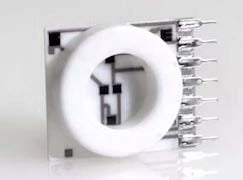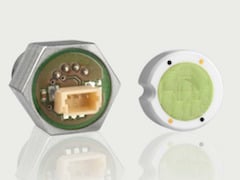Ceramic pressure sensors are utilized in a variety of ways across numerous industries – but not all sensors are created equal. While all serve the function of measuring the pressure of liquids and gases, their applications range as far as measuring oil levels in the automotive industry to supporting life-saving medical devices.
 Ceramic sensors can operate in harsh environments with extreme pressure and temperature factors at play due to their robust, stable, and cost-efficient nature. They are also valuable in applications where harsh chemicals may be present. As such, ceramic pressure sensors often present the best solution for difficult measuring applications. Many types of ceramic pressure sensors exist to address a broad range of challenges in numerous industries.
Ceramic sensors can operate in harsh environments with extreme pressure and temperature factors at play due to their robust, stable, and cost-efficient nature. They are also valuable in applications where harsh chemicals may be present. As such, ceramic pressure sensors often present the best solution for difficult measuring applications. Many types of ceramic pressure sensors exist to address a broad range of challenges in numerous industries.
Types of Ceramic Sensors
Servoflo offers a wide range of ceramic pressure sensors that can be used to measure pressure rates or fluid levels. From full transducer packages to smart metering systems, our range of ceramic sensors provides solutions for every potential application.
Flush Mount vs. Monolithic
Flush mount sensors are flat, smooth, and feature no dead volume of media pressure. Monolithic sensors, on the other hand, have an indentation in the side that is exposed to the pressure media. Flush mount solutions from Servoflo offer a wider range of pressure tolerances, from 0.5 bar to as high as 600 bar.
Which sensor you choose will be determined by your application requirements, as flush and monolithic mounts each have strengths in different areas. For example, a flush mount would be ideal if sealed gauge or absolute sensors are required by the application, while monolithic sensors are often ideal for a range of industrial automation or process control applications.
Piezoresistive vs. Capacitive
Servoflo's Metallux line of ceramic pressure sensors are, either piezoresistive or capacitive by nature. Both are resistant to corrosion and are compatible with a wide array of environmental conditions and are suitable for various industrial, automotive, or medical applications.
Capacitive sensors are often preferred for applications that feature high overpressure values but also require accurate low pressure measurement or high resolution measurements.
Differential Pressure Sensors
 The ME800 ceramic differential pressure sensors measure differential pressure using a single sensor rather than two. This saves on cost and improves accuracy by narrowing down the possibility of error. Should errors occur, a single sensor makes them easier to pinpoint, which helps you to repair, replace, or recalibrate equipment quickly and limit costly downtime.
The ME800 ceramic differential pressure sensors measure differential pressure using a single sensor rather than two. This saves on cost and improves accuracy by narrowing down the possibility of error. Should errors occur, a single sensor makes them easier to pinpoint, which helps you to repair, replace, or recalibrate equipment quickly and limit costly downtime.
Amplified vs. Unamplified
If you'd prefer to calibrate and amplify your own sensors, we offer sensors with a millivolt of output that provides a blank slate for your design. This option gives you the freedom to amplify your own transducer signal and allows you to maintain control over both pressure range and output frequency.
For users who don’t require advanced customization or are simply seeking a standardized solution, we also have calibrated, temperature-compensated sensor models that are amplified and ready for use. We can provide ratiometric, non-ratiometric, current loop, and I2C sensors that integrate directly into existing systems and provide a wide range of sensitivity suitable for myriad applications.
Ratiometric vs. Non-Ratiometric
Amplified units consist of ratiometric and non-ratiometric sensors. Which of these two models will be appropriate depends largely on the voltage requirements of the application. Generally, lower voltage applications (0.5V to 4.5V) should choose a ratiometric sensor, while applications that use 12V or more should use a non-ratiometric sensor.
Choosing the incorrect solution for your voltage requirements will impact the reliability of digital conversion readouts.
Ceramic Pressure Sensor Sizes
 Servoflo's sensors come in a variety of sizes, ranging from 9 mm (model ME900) in diameter up to 32.4 mm in diameter. The 9 mm sensor is an exciting addition to the Servoflo line of pressure sensors because it provides an ideal solution for small spaces and applications which otherwise may have been too constrictive for simple installation. The 9 mm solution comes pre-calibrated and pre-amplified, so customers must only add a cable to begin using it.
Servoflo's sensors come in a variety of sizes, ranging from 9 mm (model ME900) in diameter up to 32.4 mm in diameter. The 9 mm sensor is an exciting addition to the Servoflo line of pressure sensors because it provides an ideal solution for small spaces and applications which otherwise may have been too constrictive for simple installation. The 9 mm solution comes pre-calibrated and pre-amplified, so customers must only add a cable to begin using it.
Ceramic Pressure Sensor Solutions from Servoflo
Choosing the proper ceramic pressure sensor solution can be an intimidating process—especially when your application requires precise readings. It’s often best to consult with a sensor expert in advance of your purchase to make sure you get the ideal solution for your needs.
For more information and deeper insights, please download our eBook: Ceramic Pressure Sensors 101.



